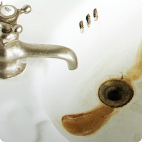Understanding Your Water Quality
The quality of your water is not something that you can assume. Here in Sparks, several factors can influence the taste, smell, texture, and functionality of the water within your household. Issues such as well water condition, potential contamination, aging water distribution systems, and the state of your home’s plumbing can all impact your water supply. Some water issues may not be immediately apparent either. That’s why it’s essential to conduct water testing to assess whether treatment is required and to identify the best solution for your needs.
Hard Water

Hard water is water with high levels of dissolved calcium, magnesium, and often iron. Whether from a private well or a municipal supply, most homes experience hard water. Many homeowners are unaware of its presence and the costly and persistent issues it can create.
Common problems associated with hard water include dry skin and hair, bathtub rings, spots on glassware, silverware, and fixtures, as well as dull and dingy clothing. Additionally, hard water can lead to reduced performance and a shortened lifespan of water-using appliances.
Check to see if you might have hard water.
Cloudy Water:

Cloudy, murky, or grayish water often results from dissolved or suspended solids, a condition known as “turbidity.” This can occur naturally or due to land disturbances like construction, storms, or urban runoff.
Turbidity levels in water can vary from low to high. Even if your water appears clear, it may still contain significant levels of dissolved solids. That’s why we recommend testing your water regardless of its appearance.
Chlorine Smell and Taste

Since the 1850s, chlorine has served as a disinfectant to eliminate harmful bacteria in water and its transportation pipes. While crucial for public health protection at treatment plants and in distribution systems, its necessity diminishes once water reaches your home.
Despite chlorine’s role in disease prevention, it comes with its own drawbacks. Chlorine often imparts an unpleasant taste and odor to water. It can also contribute to dry skin and hair, cause the colors in clothes to fade, and accelerate the deterioration of rubber seals in appliances, thereby reducing their lifespan.
Understanding Tastes and Odors

Water, in its natural state, is colorless, tasteless, and odorless. Therefore, if you detect unusual tastes or odors in your water, it’s important to investigate the cause.
Earthy or Musty Taste and Odor: These issues typically arise from compounds released during the decomposition of vegetation and are commonly associated with various forms of algae. While not harmful, they can be unpleasant even at low concentrations.
Rotten Egg Smell: Hydrogen sulfide is a frequent culprit behind foul-smelling water. This colorless, corrosive gas emits an odor reminiscent of rotten eggs. High concentrations can leave an unpleasant scent on hair and clothes and accelerate the corrosion of metal components in appliances.
Metallic Taste: Water with a metallic taste often contains metals like iron, copper, manganese, or zinc. Iron and manganese are usually naturally occurring and are prevalent in groundwater. Copper and zinc may originate from aging water distribution systems or the corrosion of copper plumbing and brass fittings.
Staining

Water, as a natural solvent, has the capacity to dissolve substances it encounters over time and under suitable conditions. Consequently, depending on your location, your water may contain iron or manganese, which can lead to rusty-orange or black staining. These stains can appear on clothing, fixtures, sinks, bathtubs, water-using appliances, and toilets.
When water has a low pH, you may notice distinctive blue-green stains on surfaces it contacts, particularly on white surfaces like sinks, tubs, showers, toilets, and even white clothing.
A free water test is a great way to get started on removing those stains.
Microbial Pathogens in Water Systems

The Centers for Disease Control and Prevention estimate that there are over 12 million cases of waterborne acute gastrointestinal illness annually in the United States alone. These illnesses are often caused by bacteria, viruses, and protozoa that contaminate the water supply. Despite the efforts of well-operated, state-of-the-art treatment plants, it is challenging to completely eliminate microbial pathogens from drinking water.
Recognize any of these issues with your water? Contact us today for a complimentary water analysis!

